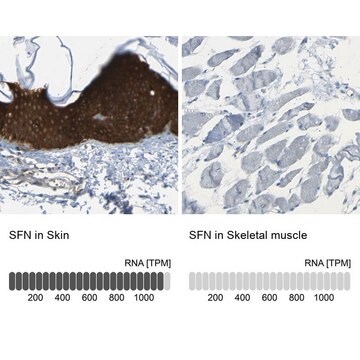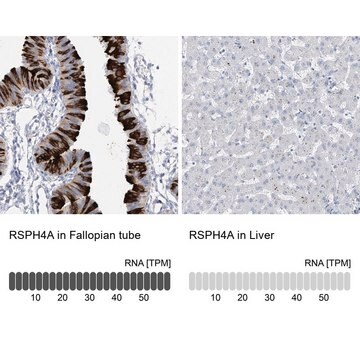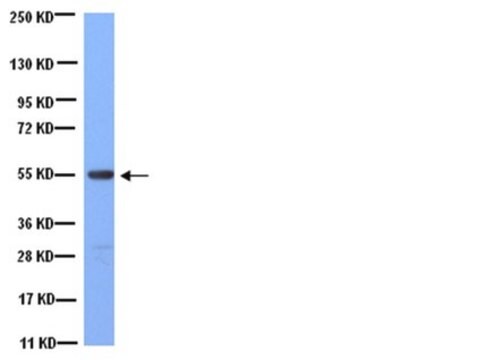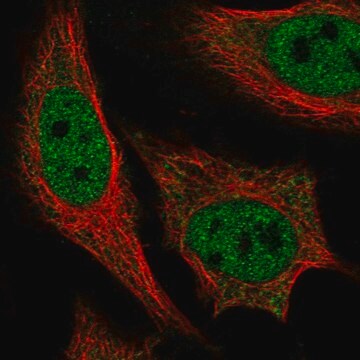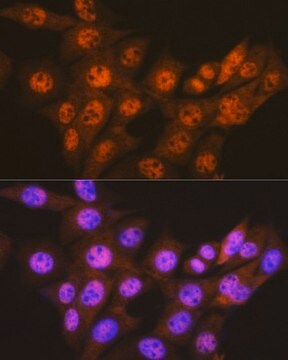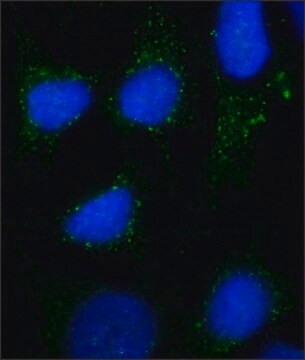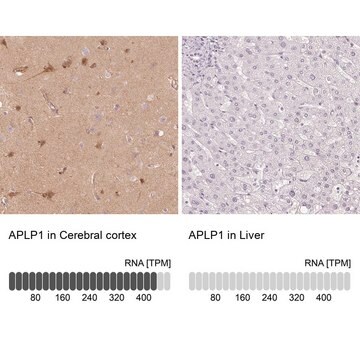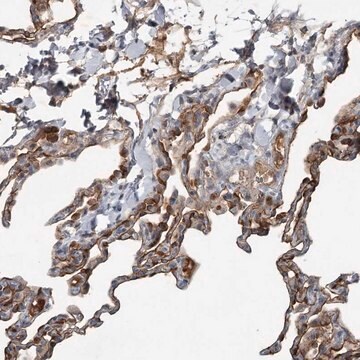推荐产品
生物源
rabbit
品質等級
共軛
unconjugated
抗體表格
affinity isolated antibody
抗體產品種類
primary antibodies
無性繁殖
polyclonal
產品線
Prestige Antibodies® Powered by Atlas Antibodies
形狀
buffered aqueous glycerol solution
物種活性
human
技術
immunohistochemistry: 1:50- 1:200
免疫原序列
EDEESIVGDGETKEPFLLVQYSAKGPCVERKAKLMTPNGPEV
UniProt登錄號
運輸包裝
wet ice
儲存溫度
−20°C
目標翻譯後修改
unmodified
基因資訊
human ... SNN(8303)
一般說明
SNN (stannin) is a mitochondrial membrane protein, which has a membrane helical region, a linker region containing conserved CXC metal-binding motif, a predictive 14-3-3ζ binding domain and a cytosolic helical region. This gene is localized to human chromosome 16p13, and has an open readin frame of 264bp. The mRNA of SNN is present in hippocampus, neocortex, cerebellum, striatum, midbrain, lung, spleen and kidney, and is absent in heart, liver, skeletal muscle and testis. This protein is made of 88 amino acids and has a molecular weight of 10kDa.
免疫原
Stannin recombinant protein epitope signature tag (PrEST)
應用
All Prestige Antibodies Powered by Atlas Antibodies are developed and validated by the Human Protein Atlas (HPA) project and as a result, are supported by the most extensive characterization in the industry.
The Human Protein Atlas project can be subdivided into three efforts: Human Tissue Atlas, Cancer Atlas, and Human Cell Atlas. The antibodies that have been generated in support of the Tissue and Cancer Atlas projects have been tested by immunohistochemistry against hundreds of normal and disease tissues and through the recent efforts of the Human Cell Atlas project, many have been characterized by immunofluorescence to map the human proteome not only at the tissue level but now at the subcellular level. These images and the collection of this vast data set can be viewed on the Human Protein Atlas (HPA) site by clicking on the Image Gallery link. We also provide Prestige Antibodies® protocols and other useful information.
The Human Protein Atlas project can be subdivided into three efforts: Human Tissue Atlas, Cancer Atlas, and Human Cell Atlas. The antibodies that have been generated in support of the Tissue and Cancer Atlas projects have been tested by immunohistochemistry against hundreds of normal and disease tissues and through the recent efforts of the Human Cell Atlas project, many have been characterized by immunofluorescence to map the human proteome not only at the tissue level but now at the subcellular level. These images and the collection of this vast data set can be viewed on the Human Protein Atlas (HPA) site by clicking on the Image Gallery link. We also provide Prestige Antibodies® protocols and other useful information.
生化/生理作用
SNN (stannin) is involved in the toxicity of organotin compounds in cells, such as trimethyltin (TMT), though it is not sufficient alone to mediate toxicity. This protein is also responsible for neuronal cell death mediated by TMT toxicity.
特點和優勢
Prestige Antibodies® are highly characterized and extensively validated antibodies with the added benefit of all available characterization data for each target being accessible via the Human Protein Atlas portal linked just below the product name at the top of this page. The uniqueness and low cross-reactivity of the Prestige Antibodies® to other proteins are due to a thorough selection of antigen regions, affinity purification, and stringent selection. Prestige antigen controls are available for every corresponding Prestige Antibody and can be found in the linkage section.
Every Prestige Antibody is tested in the following ways:
Every Prestige Antibody is tested in the following ways:
- IHC tissue array of 44 normal human tissues and 20 of the most common cancer type tissues.
- Protein array of 364 human recombinant protein fragments.
聯結
Corresponding Antigen APREST72342
外觀
Solution in phosphate-buffered saline, pH 7.2, containing 40% glycerol and 0.02% sodium azide
法律資訊
Prestige Antibodies is a registered trademark of Merck KGaA, Darmstadt, Germany
免責聲明
Unless otherwise stated in our catalog or other company documentation accompanying the product(s), our products are intended for research use only and are not to be used for any other purpose, which includes but is not limited to, unauthorized commercial uses, in vitro diagnostic uses, ex vivo or in vivo therapeutic uses or any type of consumption or application to humans or animals.
未找到合适的产品?
试试我们的产品选型工具.
儲存類別代碼
10 - Combustible liquids
水污染物質分類(WGK)
WGK 1
閃點(°F)
Not applicable
閃點(°C)
Not applicable
個人防護裝備
Eyeshields, Gloves, multi-purpose combination respirator cartridge (US)
N S Dejneka et al.
Neurochemistry international, 31(6), 801-815 (1997-12-31)
The cDNA encoding the protein stannin was isolated previously via subtractive hybridization, using differential expression after trimethyltin (TMT) intoxication, as a basis for isolating mRNA which may be expressed in TMT-sensitive cells. Initial characterization revealed a novel gene product which
S M Toggas et al.
Molecular pharmacology, 42(1), 44-56 (1992-07-01)
The molecular basis of selective vulnerability of specific neuronal populations to neurotoxicants remains a key focus in neurotoxicology. Trimethyltin (TMT) selectively damages neurons in rodent and human central nervous system after a single exposure. By coupling subtractive hybridization with molecular
N S Dejneka et al.
Mammalian genome : official journal of the International Mammalian Genome Society, 9(7), 556-564 (1998-07-10)
Stannin is a protein that has been localized to trimethyltin-sensitive cell populations, and evidence suggests it plays a role in the toxic effects of organotins. In this study, we have isolated a mouse stannin genomic clone and have characterized the
Bethany A Buck-Koehntop et al.
Journal of molecular biology, 354(3), 652-665 (2005-10-26)
Organotin compounds or alkyltins are ubiquitous environmental toxins that have been implicated in cellular death. Unlike other xenobiotic compounds, such as organomercurials and organoleads, alkyltins activate apoptotic cascades at low concentrations. Trimethyltin (TMT) chloride is amongst the most toxic organotin
我们的科学家团队拥有各种研究领域经验,包括生命科学、材料科学、化学合成、色谱、分析及许多其他领域.
联系技术服务部门